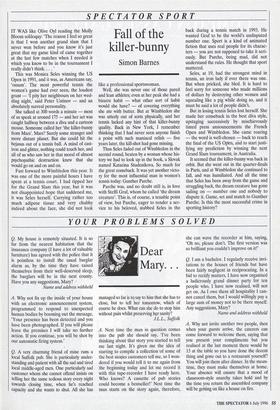SPECTATOR SPORT
Fall of the killer-bunny
Simon Barnes
IT WAS like Olive Oyl reading the Molly Bloom soliloquy: 'The reason I feel so great is that I won another grand slam that I never won before and you know it's just great that my game kind of came together at the last few matches when I needed it which you know to be in the tournament I really didn't think.. .. '
This was Monica Seles winning the US Open in 1991, and it was, as Americans say, 'ossum'. The most powerful tennis the women's game had ever seen, the loudest grunt — 'I pity her neighbours on her wed- ding night,' said Peter Ustinov — and an absolutely surreal personality.
She talked at 300 words a minute — most of us speak at around 175 — and her act was caught halfway between a diva and a cartoon mouse. Someone called her 'the killer-bunny from Mars'. Mars? Surely some stranger and more distant planet. But she could hit the bejasus out of a tennis ball. A mind of cast- iron and glitter, nothing could touch her, and all of us who saw her in that mood of almost psychopathic destruction knew that she would go on and on and on.
Fast forward to Wimbledon this year. It was one of the more painful hours I have spent at a tennis court. I had tipped her for the Grand Slam this year, but it was not disappointed hope that saddened me, it was Seles herself. Carrying rather too much adipose tissue and very chubby indeed about the face, she did not look like a professional sportswoman.
Well, she was never one of those pared and lean athletes; even at her peak she had a bizarre habit — what other sort of habit would she have? — of covering everything she ate with butter. But at Wimbledon she was utterly out of sorts physically, and her tennis lacked any hint of that killer-bunny quality. Back in New York, I remember thinking that I had never seen anyone finish a point with such maniacal relish — five years later, the kill-shot had gone missing. Thus Seles faded out of Wimbledon in the second round, beaten by a woman whose his- tory we had to look up in the book, a Slovak named Katarina Studenikova. So much for the great comeback. It was yet another victo- ry for the most influential man in women's tennis today: Gunther Parche.
Parche was, and no doubt still is, in love with Steffi Graf, whom he called 'the dream creature'. This is, of course, a tenable point of view, but Parche, eager to render a ser- vice to his beloved, stabbed Seles in the back during a tennis match in 1993. He wanted Graf to be the world's undisputed number one. Sport is a kind of animated fiction that uses real people for its charac- ters — you are not supposed to take it seri- ously. But Parche, being mad, did not understand the rules. He thought that sport mattered.
Seles, at 19, had the strongest mind in tennis, an iron lady if ever there was one. But when pricked, she bled. It is hard to feel sorry for someone who made millions of dollars by destroying other women and squealing like a pig while doing so, and it must be said a lot of people didn't..
But in losing tennis Seles lost herself. She made her comeback in the best diVa style, upstaging successively by mischievously timed press announcements the French Open and Wimbledon. She came roaring — the word is well-chosen — back to reach the final of the US ()Oen, and to start justi- fying my prediction by winning the next Grand Slam tournament, in Australia.
It seemed that the killer-bunny was back in orbit. But she went out in the quarter-finals in Paris, and at Wimbledon she continued to fall, and was humiliated. And all the time that Seles has been away from the game and struggling back, the dream creature has gone sailing on — number one and nobody to dispute it. Game, set and match to Gunther Parche. Is this the most successful crime in sporting history?


























































 Previous page
Previous page